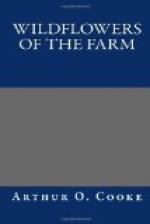Now look at the leaves; each has three leaflets. If you can find a leaf with four of these leaflets, the country children will think you very fortunate, for a four-leaved Clover is said to bring good luck, just as a four-leaved Shamrock does in Ireland. A four-leaved Clover is, however, rather rare; I hope you may find one, but I am rather afraid you will not.
Here is another Clover, not quite so handsome as the Red Clover at which we have just been looking; the flowers are white, and are rather smaller. This is White or Dutch Clover. It is a perennial plant, and one which spreads over a great deal of ground if it is allowed to do so. We saw, you remember, that the ivy-leaved Toadflax on the wall by the foldyard steps sent out fresh roots from its stems as it grew. The White Clover does the same. The stems creep along the ground, send out fresh roots, and in this way the plant spreads quickly.
Keeping a few stems of both these clovers in our hands we will go a little further up the lane. There, in a field, we shall see something that even country people cannot see every day. The Clover which farmers usually sow is either the Red Clover or the White, or else another kind called Alsike. This year Mr. Hammond has sown a field with a fourth kind—Crimson Clover.
Did you ever see a more beautiful sight? The whole field is a blaze of rich crimson colour. I shall never forget the day I first saw a field of Crimson Clover. I was so delighted that I asked the farmer—not Mr. Hammond, but another friend—if he would have a field of it for me to admire every year! He said he would tell me by and by. At the end of the year he said he did not find it such a useful food for his animals as the Red and White Clovers, and he should not sow it again—at least not very soon. You see pretty things are not always the most useful.
Let us see what differences we can find between the three clovers we have gathered. We look first at the blossoms. That of the Red Clover is, as we have said, like a little round ball, or knob. The flower of the White Clover is of much the same shape, but is less fine. The flower of the Crimson Clover is altogether different in shape. It has indeed many small crimson stems, but these do not form a round ball. They are arranged in the form of a little circular cone or pyramid which is large at the bottom and pointed at the top.
[Illustration: Clover leaves. 1. White; 2. Crimson; 3. Red.]
There are other differences. Immediately below the flower of the Red Clover is a pair of leaves; the blossom is said to be “sessile” or seated on these leaves. Other leaves, and also other blossoms, grow on the same stem. Now look at the White Clover. The blossom grows on a stalk without any leaves or other blossoms on it—only the single blossom at the top of the stalk. The blossom of the Crimson Clover has leaves below it.
To-day we easily distinguish one clover from the others by the flowers. Supposing, however, that we looked at them some day before the flowers were out; what then? Are there any differences in the leaves? All three have leaves formed of three leaflets—they are trefoils—but the leaves are otherwise different.




